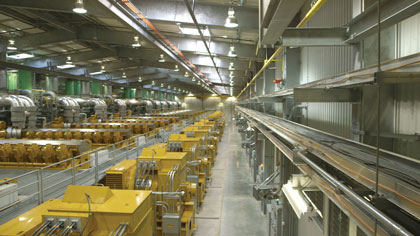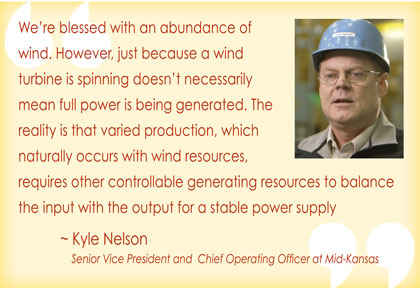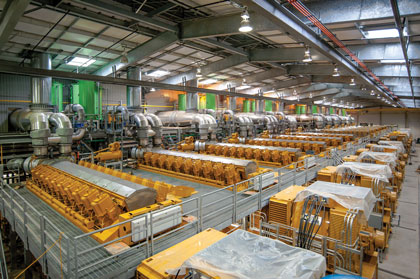In 1957, six western Kansas rural electric distribution cooperatives created Sunflower Electric Power Corporation to purchase and develop a reliable, long-term power supply. In 2007, members of Sunflower formed Mid-Kansas Electric Company, an affiliated generation and transmission company, to support a business acquisition. Today, Mid-Kansas, which is governed by a democratically elected board of directors, provides wholesale services to its six members serving electric consumers across thirty-three counties in central and western Kansas.

Rubart Station has become the most efficient installation in the Mid-Kansas portfolio and Caterpillar’s largest natural gas-powered facility in the world.
POWER NEED
Mid-Kansas has a power generation portfolio made up of coal, natural gas, wind resources and transmission line assets that include more than 1000 miles (1609 kilometers) of high-voltage lines ranging from 115 to 230 kilovolts. This diversified portfolio allows Mid-Kansas to provide reliable energy and transmission service at the lowest possible cost to its members.
In 2012, the Mid-Kansas team began formal planning for ways to meet the growing demand for electricity and provide voltage support in the area. Also at issue were southwest Kansas’ highly intermittent wind resources, which result in a constantly shifting generation production due to wind fluctuations at any given time. These factors gave rise to the need for a highly flexible power generation system to accommodate such rapid system changes.

SOLUTION
The Mid-Kansas team spent months visiting reciprocating engine-based generating facilities to learn about the technology and configurations of different facilities. A technology selection study completed by Burns and McDonnell, a full-service engineering, architecture and construction firm, identified that reciprocating internal combustion engines (RICE) could provide flexible and cost-effective generation.
This benefits Mid-Kansas’ members in the Integrated Market, which includes a day-ahead look at potential load generation to determine the most reliable and economical combination of generation resources, by serving the load and dispatch generation to meet real-time load across a nine-state footprint.
After Caterpillar’s new 20-cylinder RICE units became the technology of choice, Mid-Kansas partnered with Caterpillar and Burns and McDonnell to construct a new generation facility, Rubart Station—named after Perry Rubart, long-time Pioneer Electric Cooperative trustee. Construction began in February 2013, and the facility was completed nineteen months later.
Located just 13 miles (20.9 kilometers) east of Ulysses, Kansas, Rubart Station is powered by twelve Cat® G20CM34 natural gas RICE units and has a nominal 110 megawatt output capability. The efficiency and fast-start feature of the G20CM34 allow a quick response to the Integrated Market’s conditions, often affected by the massive wind penetration in southwest Kansas.
“It’s easy to see the benefits of Caterpillar’s RICE technology when we analyze the fast start time, quick response to changing load demands and high-efficiency performance,” said Steve Ricard, executive manager of generation at Mid-Kansas. “If needed, we could run at full load—that’s 110 megawatts of power – in less than nine minutes. That’s pretty impressive.”
The availability of resources in the area and environmental impact were also critical to Mid-Kansas’ choice of technology. For example, the proximity of Rubart Station to natural gas pipelines and low fuel costs make the G20CM34 an economical and clean-burning choice for the facility. A concern for water conservation in an area of Kansas often plagued by drought was another consideration. Rubart Station utilizes a closed-loop cooling system, which reduces water use by recycling cooling water rather than using an open-loop, evaporative cooling process.

Moreover, Rubart Station was permitted under the U.S. Environmental Protection Agency’s Prevention of Significant Deterioration (PSD) permit program, which is designed to prevent significant environmental impact from large sources of air pollution. Rubart Station’s major source PSD permit allows for unlimited hours of operation, which provides tremendous operational capability to this highly flexible generating asset.
“Reciprocating engine facilities have a unique capability for maintaining a very flat efficiency curve across a wide load range,” Nelson said. “Rubart Station adds high efficiency, low emissions and virtually no water consumption to our portfolio, which cannot be achieved with any other Mid-Kansas asset. The facility can produce 10 megawatts, 110 megawatts, or anything in between without losing efficiency, and that’s an enormous advantage for us.”
In addition to cutting-edge Caterpillar technology, Rubart Station includes forward-looking building design. No detail was too small, as stairwell placement, cable tray layout, module spacing, convenience of access points, forklift mobility and overhead hoist width were all thoroughly considered. Even the smallest details helped build a strong foundation for Rubart Station, which supports the Mid-Kansas generation portfolio in multiple ways.
“We had a very robust due diligence process when planning and designing Rubart Station,” said Paul Reynolds, senior manager of generation engineering and environment at Mid-Kansas. “While we applied some features that worked for others, we also tried to learn from their experience. Rubart Station was built from the ground up, so we had the opportunity to control many facets of the design, and we listened to and learned from the experiences of others.”
“We like to think of Rubart Station as the Swiss Army knife of our power generation portfolio because its capabilities are so diverse and the project execution was excellent,” said Nelson.

Rubart Station is powered by twelve Cat® G20CM34 natural gas RICE units and has a nominal 110 megawatt output capability.
RESULTS
Rubart Station is also permitted for an additional 110 megawatts of Caterpillar engines. Burns & McDonnell developed a site plan incorporating enough space to install twelve more engines, if the need arises. Caterpillar technicians and engineers continue to serve Rubart Station with parts and maintenance support.
“Caterpillar was very dedicated to the success of this project, and any challenges we had along the way were met head on,” said Tom Dinkel, project supervisor at Rubart Station. “The Cat products are very reliable, and the team works very, very hard to provide everything we need.”
While Rubart Station has become the most efficient installation in the Mid-Kansas portfolio, it is also Caterpillar’s largest natural gas-powered facility in the world to date.
“Caterpillar’s mission and goals line up with what we’re trying to achieve here through reciprocating engine technology,” said Derek Seacat, project manager at Rubart Station. “Rubart Station is fast, efficient and environmentally friendly, which couldn’t have been achieved without Caterpillar. They’ve gone above and beyond for us.” ■
About The Author
Cinthia Hertel is a communications manager with Mid-Kansas Electric Company. For more information about Caterpillar Energy Solutions, visit www.catpowerplants.com.
MODERN PUMPING TODAY, March 2015
Did you enjoy this article?
Subscribe to the FREE Digital Edition of Modern Pumping Today Magazine!


